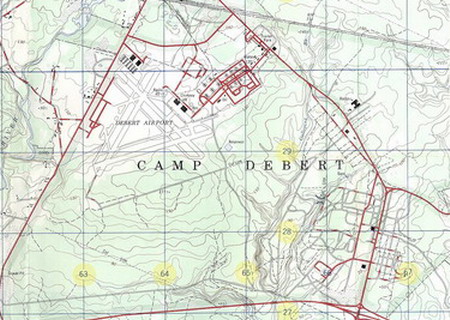NewsCheck Out The CDA Paintball Forum!! ___________________ CDA Paintball Waiver Form Click the link above for a pdf of the waiver form you and your guardian (if under 18) will be required to read & sign before you will be allowed to play at Camp Debert Army Paintball.
|
CDA Paintball Site HistoryCamp Debert Army Paintball occupies part of the former site of Camp Debert. The camp was a major Canadian military installation from its inception in 1940 during the Second World War, to its time as a government nuclear fallout bunker in the 1960s, lessening in importance until its decommissioning in 1998. Please read the following brief history of Camp Debert. (click map to enlarge) Debert Military Camp
Following the outbreak of the Second World War in the fall
of 1939, the first Canadian units began shipping through the On
Following the war, RCAF Station Debert
In the fall of 1938 the Royal Canadian Air Force (RCAF) purchased land for constructing an aerodrome on the north shore of Cobequid Bay near the farming community of Debert. Construction of the aerodrome, which would be named RCAF Station Debert, began in the fall of 1940 and was completed in April, 1941, coinciding with the construction of the army's adjoining Camp Debert. The airfield itself consisted of three 4,200 foot runways arranged in an overlapping triangle. RCAF Station Debert was one of several similar facilities constructed in the Maritime provinces in support of the British Commonwealth Air Training Plan and operational coastal patrol requirements. Following the war, RCAF Station Debert underwent some downsizing but continued to support active flight operations as a training, refueling, and maintenance base until 1954 even though no operational squadrons were stationed there. In 1960, the RCAF transferred its aerodrome to the Royal Canadian Navy (RCN) which used the facility for aircraft carrier landing practise in support of naval aviation aircraft stationed at nearby Royal Canadian Naval Air Station (RCNAS) Shearwater. Also in the 1960s, some unused hangar space at the aerodrome was used to house a medical equipment supply depot which was used by all three branches of the armed forces. On February 1, 1968, the merger of the three service branches into the unified Canadian Forces saw the end of flight operations at the Debert aerodrome and in 1971 the Department of National Defence designated 4800 acres (19 km²), consisting of the aerodrome and the majority of the training area used by the former Camp Debert, as surplus. The provincial government purchased this land for development into the "Debert Air Industrial Park" while the aerodrome continues to be used as a municipal airfield, known as Debert Airport. The Maritime "Diefenbunker"In 1958, at the height of the Cold War and the infancy of
the ICBM threat, Debert was selected as the site for 1 of 6 communication
centers and "Regional Emergency Government Headquarters" complexes being located
across Canada. The Debert facility would be the only such complex built in
the Maritime provinces. A small part of Opening in 1964, the Debert facility was already dated, since ICBM targeting had improved to the point where a direct hit was possible on the bunker, however it persisted as a Provincial Warning Centre (for Nova Scotia), staffed by the 720 Communication Squadron, along with the space for the emergency government. Antenna farms were dispersed from the bunker and were located on the shores of Cobequid Bay in nearby Masstown as well as in the Cobequid Hills near Londonderry. On February 1, 1968, the merger of the three service branches into the Canadian Forces saw the Diefenbunker and support facilities, the last remnants of Camp Debert, change its name to Canadian Forces Station Debert (CFS Debert), in keeping with the naming convention for minor military facilities across Canada. In the 1970s, CFS Debert, as with most Diefenbunker facilities across the country, was downgraded further as the number of personnel were reduced. Attempts to find other uses for the remaining military facilities took place through the 1980s with militia reserve units training at CFS Debert. The end of the Cold War and reduction in the ICBM threat, as well as the Diefenbunker's obsolescence, saw all remaining military personnel removed from CFS Debert by the mid-1990s. In 1998 the Department of National Defence finished all environmental assessments and decommissioned the facility, transferring the facility to "Colchester Park", a local development authority. Today the only remnant of a once-vast military presence in
Debert is a small-arms firing range used by militia reserve units from
Cumberland, Colchester and Pictou counties. In 2005, the Royal Canadian
Air Cadets acquired the bunker for its
|
News
News
Be sure to sign up for our newsletter or join our Facebook group so you won't miss any of the news, special events, and special promotions coming out of CDA Paintball. |




